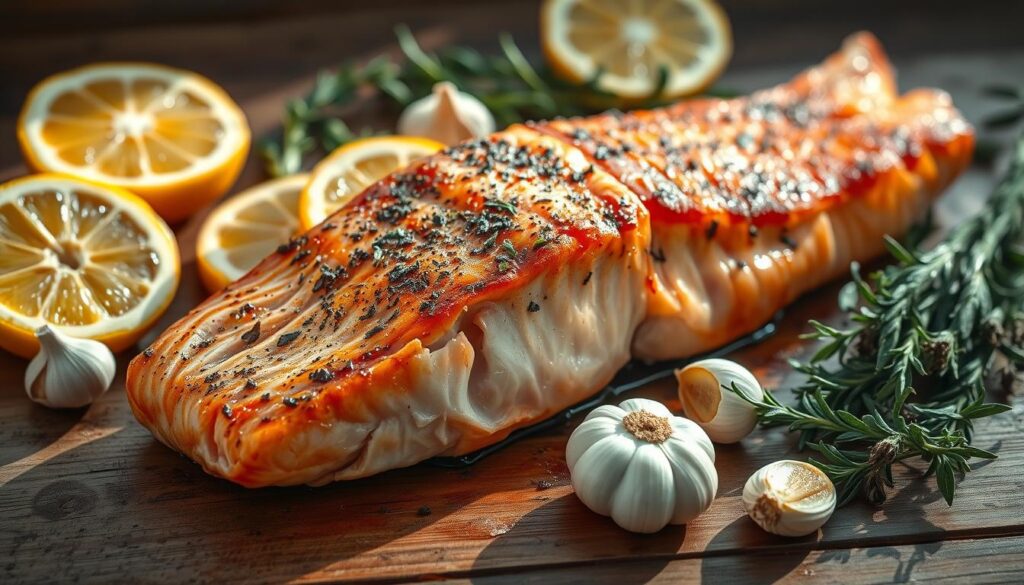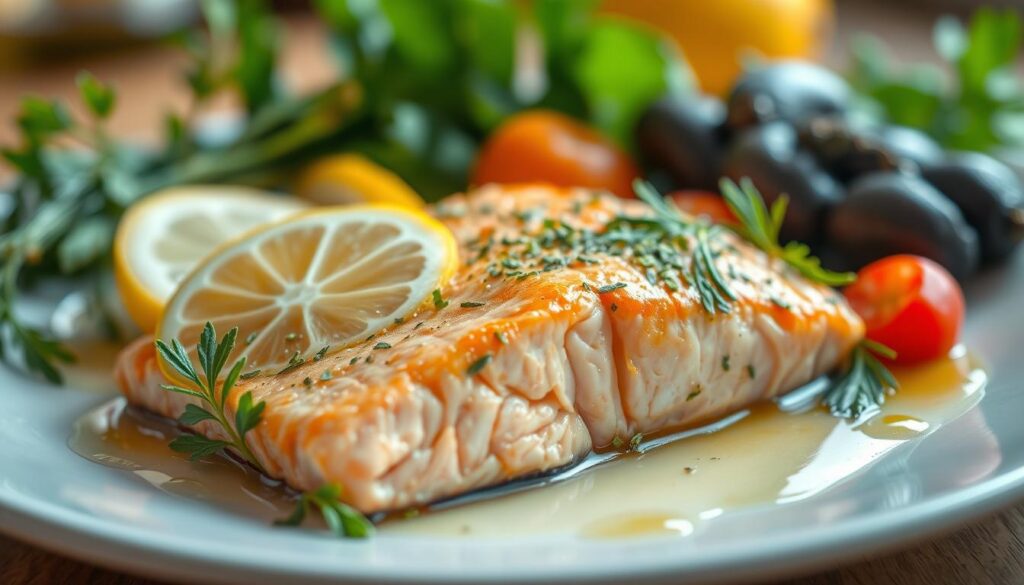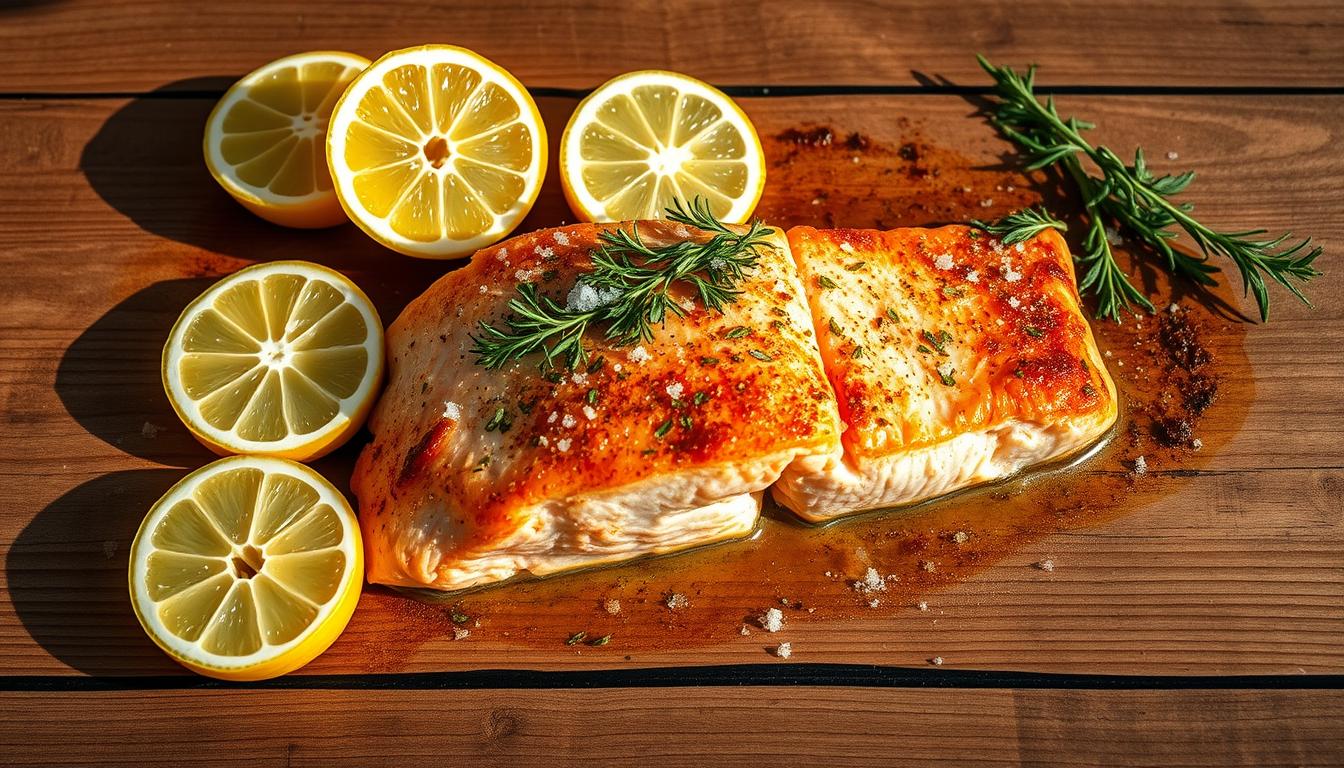Salmon Oven Lemon Garlic: Easy and Delicious Recipe
Salmon Oven Lemon Garlic: Easy and Delicious Recipe
Ever crave a restaurant-quality meal but dread the prep time? Imagine pulling a flavor-packed dish from your oven in under 30 minutes – no chef skills required. This recipe transforms hectic evenings into moments of joy, blending simplicity with bold tastes that’ll make you feel like you’re dining seaside in Santorini.
We’ve all faced those nights where takeout menus tempt us. But what if you could create something better than delivery? Picture tender fish infused with zesty citrus and aromatic herbs, steaming hot in its own little flavor pouch. The magic happens while you relax – no babysitting pans or complicated techniques.
Perfect for date nights or family dinners, this method guarantees moist results every time. Foil packets lock in moisture while keeping cleanup laughably simple. You’ll spend more time enjoying your meal than scrubbing dishes – now that’s what I call a win-win.
Table of Contents
Key Takeaways
- 20-minute cooking time with minimal hands-on effort
- Foil-wrap technique ensures juicy, never-dry results
- Balances bright Mediterranean flavors with everyday convenience
- Adaptable for casual meals or impressive dinner parties
- Nutrition-packed dish with 34g protein per serving
- Pairs perfectly with roasted veggies or fresh salads
Introduction: Discover the Magic of Salmon Oven Lemon Garlic
Transform your weeknight dinners with a burst of coastal sunshine on your plate. This dish wraps bold Mediterranean character in a foolproof package, marrying bright citrus notes with earthy depth. Forget bland meals – here, every bite sings with purpose.

Where Zest Meets Warmth
The secret lies in balancing tangy lemon juice with garlic’s subtle kick. Fresh oregano and parsley add grassy freshness, while a drizzle of olive oil ties everything together. Unlike heavy sauces, this combo lets the main ingredient shine without overpowering it.
Your New Go-To Meal
What makes this recipe special? Simplicity meets sophistication. You get restaurant-worthy taste without julienning veggies or mastering knife skills. The foil-packet method locks in moisture, ensuring tender results even if you’re multitasking.
Ready in under 15 minutes of active prep, it’s perfect for busy nights. Plus, cleanup involves tossing foil – no scrubbing baked-on residue. Stay tuned to learn how these vibrant flavors come together effortlessly.
Understanding the Health Benefits of Salmon
Your plate holds more power than you think – especially when it features this oceanic superstar. Packed with nutrients that fuel your body and protect your heart, this protein-rich fish delivers more than just great taste. Let’s explore why nutritionists call it one of nature’s most complete foods.

High Protein and Omega-3 Rich
A 3-ounce serving packs 22 grams of protein – nearly half your daily need. This helps maintain muscle mass and keeps you full longer. But the real magic lies in its omega-3 fatty acids. With 1.5-2 grams per serving, these fats slash inflammation and support brain function.
Research shows regular consumption can lower blood pressure and improve cholesterol levels. The antioxidant astaxanthin gives the flesh its pink hue while fighting cellular damage. It’s like sunscreen for your cells!
Low Saturated Fat Advantages
Compared to red meat, this seafood choice contains 75% less saturated fat. A 3-ounce portion has just 7 grams of total fat, making it ideal for heart-conscious eaters. You’ll also get a powerhouse of nutrients:
- Vitamin B12 for nerve health
- Potassium to balance blood pressure
- Selenium for immune support
This aligns perfectly with Mediterranean diet principles, emphasizing whole foods and healthy fats. Swap steak for this flaky fish twice weekly to boost longevity without sacrificing flavor.
Essential Ingredients and Kitchen Tools
Great meals start with quality components – let’s build your flavor foundation. You’ll need seven core ingredients to create this vibrant dish: fresh herbs, citrus, aromatic spices, and premium protein. Having everything prepped before heating your appliance ensures stress-free execution.
Gathering Fresh Herbs and Spices
Reach for bright, aromatic elements that wake up taste buds. Fresh parsley adds grassy notes, while dried oregano delivers earthy depth. Sweet paprika brings subtle warmth without overpowering – combine these with minced garlic cloves for layered complexity.
Key flavor boosters include:
- Extra-virgin olive oil for richness
- Zesty citrus juice (1 medium fruit)
- Sea salt and cracked pepper
Choosing the Right Protein
Opt for salmon fillets with silvery skin still attached – it protects delicate flesh during cooking. Look for:
- Bright pink color without gray spots
- Firm texture that springs back when pressed
- Mild oceanic aroma (never fishy)
Wild-caught varieties offer superior flavor, but responsibly farmed options work beautifully. Keep portions around 6 ounces each for even cooking. Pair your selected ingredients with these tools:
- Heavy-duty foil packets
- Rimmed baking sheet
- Small bowls for mixing spices
With fresh olive oil drizzled and salmon fillets prepped, you’re ready to transform simple elements into something extraordinary.
Preheating and Preparing Your Oven
Your cooking journey begins before you even turn a knob. Proper heat management separates perfectly flaky results from disappointing dinners. Let’s set the stage for success with smart prep work.
Proper Oven Temperature and Foil Techniques
Start by preheating your appliance to 375°F or 425°F – these mid-range temps cook proteins gently while crisping edges. Lower heats prevent drying; higher settings create caramelization. Always verify with an oven thermometer for accuracy.
Heavy-duty foil becomes your best ally here. Create a loose tent over your rimmed baking sheet, leaving room for steam circulation. Brush the foil lightly with oil to avoid sticking – this simple step saves cleanup headaches later.
Position fillets skin-side down in the center, spaced 2 inches apart. The rimmed sheet catches juices, preventing spills. For extra protection, double-layer the foil when using acidic marinades.
Remember: Heat rises unevenly in cold appliances. Skipping the preheat step leads to overcooked bottoms and raw tops. Set a timer for 10-15 minutes while you prep ingredients – your patience pays off in tender, evenly cooked meals.
Creating the Perfect Lemon Garlic Sauce
A great sauce transforms good dishes into unforgettable meals. This vibrant blend does exactly that – it’s sunshine in a bowl, balancing sharp citrus with earthy depth. Let’s build your flavor foundation one whisk at a time.
Mixing Olive Oil, Lemon, and Garlic
Start with quality extra-virgin olive oil as your base – its fruity notes carry other flavors beautifully. Add freshly squeezed citrus juice for brightness, then minced garlic cloves for warmth. Whisk these three until emulsified, creating a silky texture that clings to every bite.
Sweet paprika adds subtle smokiness, while cracked pepper brings gentle heat. “The secret lies in tasting as you go,” says chef Maria Santos. “Adjust ratios until your tongue tingles with excitement.”
Balancing Flavors with Fresh Herbs
Chopped oregano or parsley lifts the sauce from tasty to transcendent. These greens add grassy freshness that cuts through richness. For extra zing, stir in lemon zest – its oils intensify the citrus punch without overwhelming.
Too tangy? Drizzle honey. Prefer creaminess? Blend in Greek yogurt. This versatile sauce adapts to your palate while keeping its bold character. Store leftovers in airtight containers – it pairs brilliantly with grilled veggies or crusty bread.
Step-by-Step Recipe Instructions
Master the art of perfectly cooked fish with this effortless guide. Follow these precise techniques to lock in moisture while creating a golden finish that delights both eyes and taste buds.
Preparing and Seasoning the Fillet
Start by patting your protein completely dry using paper towels. This simple step ensures seasonings stick better and prevents steaming. Drizzle high-quality oil evenly over both sides, then sprinkle with sea salt and cracked black pepper.
Rub minced aromatics onto the surface for depth. Add citrus slices for brightness – their natural juices will infuse during cooking. “Even distribution is key,” notes chef Amanda Rhee. “Think of it as flavor armor protecting every bite.”
Wrapping, Baking, and Broiling Techniques
Create a foil pouch with enough space for heat circulation. Place the seasoned fillet skin-side down, then fold edges tightly to trap steam. Bake at 400°F for 12-15 minutes – thicker cuts may need 3 extra minutes.
Unwrap carefully (watch for hot steam!) and broil for 60-90 seconds to caramelize the top. Use a thermometer to check doneness:
- 125°F: Velvety texture
- 135°F: Firm flakes
- 145°F: Well-done
Rest for 5 minutes before serving. This pause lets juices redistribute, guaranteeing succulent results from edge to center.
Mastering Salmon Oven Lemon Garlic
Ever pulled fish from the oven only to find it rubbery? Perfect results come from precise timing and smart techniques – not luck. Let’s crack the code for fork-tender texture every time.
Timing Is Everything
Thicker cuts need 18-22 minutes at 375°F, while slim fillets cook in 12-14. Watch the clock like a hawk – even 2 extra minutes can turn juicy to jerky. Ovens lie: use a thermometer to verify temps. “Your eyes are better tools than any timer,” says seafood chef Eli Krantzberg.
Method Matters Most
Follow this fail-proof system:
- Place fillets on middle rack for even heat
- Peek through the oven window instead of opening the door
- Test doneness by gently separating flakes with a fork
Let cooked fish rest 5 minutes – this pause lets juices settle. For caramelized edges, broil 90 seconds at the end. Thermometers should read 125-135°F depending on preferred doneness.
Remember: Each appliance behaves differently. Track cooking times in a notebook until you nail your oven’s quirks. Soon, you’ll serve restaurant-quality meals without second-guessing.
Dynamic Techniques: Baking vs. Broiling
Your kitchen holds two secret weapons for creating texture contrasts that elevate simple meals. Mastering these heat methods unlocks flaky tenderness beneath a caramelized crust – the hallmark of top-tier recipes.
Steam-Powered Perfection
Baking in foil acts like a flavor sauna. The sealed pouch traps moisture, gently cooking proteins without drying them out. This method works wonders for thicker cuts, preserving natural juices while infusing herbs and spices. “Foil packets create a microclimate,” explains chef Lorraine Bracco. “It’s like giving your meal a spa day.”
Crispy Finish Formula
Broiling transforms steamed surfaces into golden masterpieces. After baking, move your rack to the upper third position. This distance prevents burning while allowing intense heat to caramelize edges. Watch closely – 90 seconds can mean the difference between bronze perfection and charcoal disaster.
For best results:
- Pat surfaces dry before broiling
- Brush lightly with oil for even browning
- Rotate the pan halfway through
The magic happens when these techniques combine. Steam first for moisture, then blast with heat for texture. Sprinkle fresh cracked pepper post-broil to maximize its aromatic punch. This dual approach makes our featured recipe stand out among other seafood dishes.
Serving Suggestions and Complementary Sides
Balance rich flavors with fresh, vibrant sides that elevate every bite. The right accompaniments turn your dinner into a textured experience, contrasting creamy textures with crisp finishes while soaking up every drop of sauce.
Pairing with Fresh Salads and Rice
A zesty Greek tomato-cucumber salad cuts through the dish’s richness with juicy acidity. Toss in red onion and feta for salty tang. Grain lovers will appreciate herbed jasmine rice – its fluffy grains absorb the citrus-infused juices beautifully.
For lighter options, try quinoa tossed with kale and roasted veggies. The nutty flavor profile complements without overpowering. “Always include something crunchy,” advises chef Marco Bianchi. “It keeps each forkful exciting.”
Delicious Starchy and Vegetable Options
Roasted rosemary potatoes offer crispy edges and tender centers – ideal for scooping up extra sauce. Sweet potato cubes drizzled with honey add caramelized sweetness that balances savory notes.
Sautéed green beans or asparagus bring earthy freshness. Finish with a squeeze of citrus to tie all flavors together. These sides transform your plate into a colorful feast worthy of weekend gatherings or quick weeknight dinners.
Variations to Customize Your Recipe
Why settle for one flavor profile when you can craft endless combinations? This dish thrives on personal touches – swap ingredients to match your mood or pantry staples. A few smart tweaks transform the base recipe into something uniquely yours.
Experimenting With Spice Mixes
Ditch the standard seasoning for bold new blends. Smoked paprika adds campfire warmth, while Italian herbs bring garden-fresh complexity. For heat lovers, ground chipotle or cayenne pepper delivers a fiery kick that balances the citrus base.
Try these easy swaps:
- Za’atar for earthy Middle Eastern notes
- Fennel seeds with ground coriander for licorice undertones
- Everything bagel seasoning for crunch
Adapting the Sauce for Different Tastes
Your sauce acts as a flavor playground. Swap lemon for lime to make lemon garlic sauce morph into tropical territory. Stir in Dijon mustard for tangy depth or honey for caramelized sweetness. Even Greek yogurt works for creamier textures without heavy calories.
Herb enthusiasts can fold in fresh dill or tarragon. For smoky richness, blend roasted red peppers into the mix. Each variation keeps the garlic salmon essence while introducing exciting new dimensions. “The best recipes evolve with your cravings,” notes food blogger Tina Chen.
Share your lemon garlic salmon twists online – your innovation might inspire someone’s new favorite meal. Whether you prefer zesty heat or herbal freshness, these adjustments let you make lemon garlic magic your own way.
Troubleshooting Common Salmon Cooking Issues
Even seasoned cooks face challenges when working with delicate proteins. Dryness and uneven seasoning plague many home kitchens, but simple fixes transform kitchen fails into culinary wins.
Keeping Fish Moist and Tender
Timing makes or breaks your dish. Set a timer for 12 minutes at 400°F as your baseline – thicker cuts need 3 extra minutes max. Use foil packets like edible armor: loosely wrap fillets to trap steam without squeezing them.
An instant-read thermometer prevents guesswork. Pull fish at 135°F – residual heat brings it to 145°F during resting. Chef Emily Wu notes: “Overcooked proteins can’t be revived, but undercooked ones get a second chance.”
Fine-Tuning Flavors and Timing
If your first bite lacks zing, add cracked black pepper or flaky salt post-cooking. For bland results, mix 1/4 teaspoon black pepper with citrus zest as a finishing sprinkle. Adjust cooking time based on thickness:
- 1-inch fillets: 12-14 minutes
- 1.5-inch cuts: 16-18 minutes
- Variable sizes: check every 90 seconds after 12 minutes
Remember – ovens vary. Track your appliance’s quirks in a cooking journal. With these adjustments, you’ll master baked salmon that rivals professional kitchens.
Conclusion
Transform ordinary dinners into vibrant feasts with this foolproof method. By combining zesty citrus, aromatic cloves, and fresh parsley in a simple marinade, you create a flavor explosion that elevates any meal. The technique of wrapping seasoned fish in foil locks in moisture while letting herbs work their magic.
Remember the essentials: a quick prep with olive oil, a squeeze of lemon juice, and minced garlic forms your flavor foundation. Toss ingredients in a mixing bowl for even coating – this step ensures every bite bursts with brightness. Health-conscious cooks appreciate the dish’s omega-3 richness and lean protein benefits.
Don’t hesitate to tweak herb combinations or try new spice blends. Whether you’re cooking for one or hosting friends, this recipe adapts effortlessly. Share your culinary twists online – your creativity might spark someone’s next kitchen adventure.
Thank you for exploring this flavorful journey. May your meals always balance nourishment with pure deliciousness!

